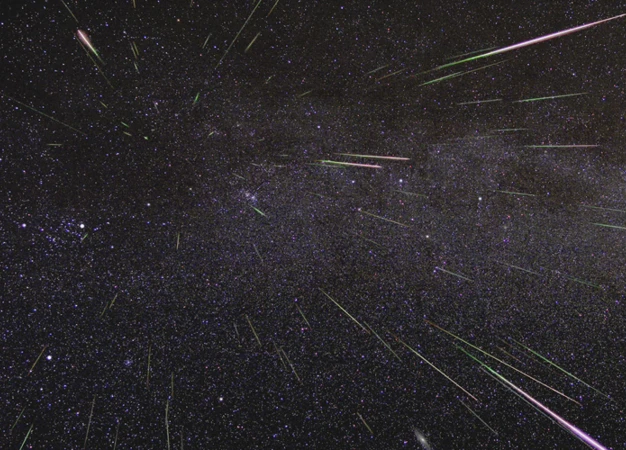The Perseid Meteor Shower: Nature’s Fireworks Display
Every year, in the month of August, stargazers around the world get ready for a breathtaking celestial event known as the Perseid Meteor Shower. This mesmerizing display of shooting stars has captivated humans for centuries, leaving us in awe of the wonders of the universe. As the Earth passes through the debris left behind by the comet Swift-Tuttle, particles burn up in our atmosphere, creating a stunning spectacle of light. In this article, we will uncover the origins of the Perseid Meteor Shower, the best spots to view this celestial phenomenon, tips for photographing the meteor shower, notable years, and fascinating facts that will leave you starstruck. So grab your binoculars, find a cozy spot, and prepare to be dazzled by nature’s very own fireworks show.
Origins of the Perseid Meteor Shower
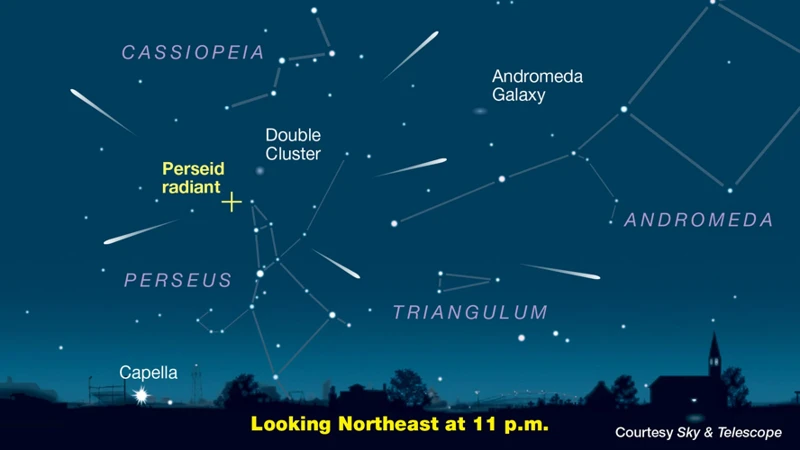
The Perseid Meteor Shower gets its name from the constellation Perseus, from which the meteors appear to originate. But what causes this stunning celestial show? The answer lies in the debris left behind by the comet Swift-Tuttle. As this comet orbits the Sun, it sheds dusty particles, rocks, and ice, forming a trail in its wake. When the Earth intersects this trail during its own orbit, these particles enter our atmosphere at high speeds. The friction between the particles and the air leads to their incineration, creating the fiery streaks across the night sky that we know as meteors. The Perseids are particularly spectacular because they consist of larger, more dense particles compared to other meteor showers. The comet Swift-Tuttle has a long orbital period of about 133 years, and its last visit in 1992 resulted in an especially impressive meteor shower. So, as the Earth ventures through the remnants of Swift-Tuttle’s cosmic journey, we are treated to the awe-inspiring spectacle of the Perseid Meteor Shower.
Best Viewing Spots
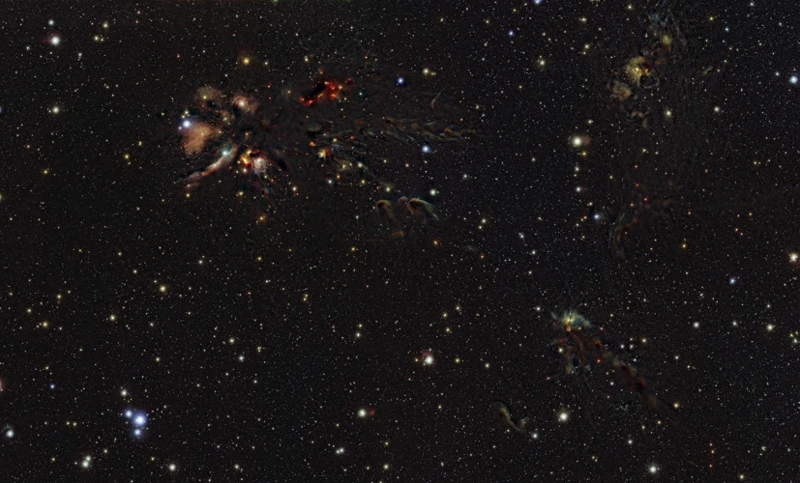
To truly experience the magic of the Perseid Meteor Shower, finding the perfect viewing spot is crucial. Here are some of the best locations to catch nature’s fireworks display:
1. Dark Sky Locations: Seek out areas with minimal light pollution. National parks, remote countryside, or observatories are ideal for an unobstructed view of the night sky. One extremely popular dark sky location is Jasper National Park in Canada, where visitors can witness the Perseids amidst the pristine wilderness.
2. Away from City Lights: The bright lights of cities can significantly diminish the visibility of the meteor shower. Head to rural areas or coastal regions to escape the glow of urban environments. The coastal town of Galloway in Scotland, known for its dark skies, offers a peaceful setting to marvel at the Perseids.
3. High Elevation Areas: Climbing to higher elevations can enhance your viewing experience. Mountains, hills, or even rooftop terraces provide an elevated vantage point. The Mauna Kea summit in Hawaii, home to world-renowned observatories, offers an exceptional viewpoint for observing celestial wonders.
Remember, wherever you choose to watch the Perseids, ensure you have a clear, open sky and comfortable seating arrangements. So find a suitable spot, lay back, and get ready for the celestial extravaganza that awaits you.
1. Dark Sky Locations
1. Dark Sky Locations
When it comes to observing the Perseid Meteor Shower, finding a dark sky location is key to enhancing your viewing experience. Away from the bright lights of cities, these locations offer optimal conditions for spotting shooting stars. Here are some top dark sky locations you can consider:
a. Joshua Tree National Park, California: Known for its stunning desert landscape, Joshua Tree National Park provides expansive views of the night sky, away from urban light pollution. Set up your blanket, lie back, and watch as the Perseids light up the heavens.
b. Cherry Springs State Park, Pennsylvania: This state park is recognized as one of the darkest spots on the East Coast of the United States, making it a prime location for stargazing. With designated viewing areas and minimal light interference, Cherry Springs offers a front-row seat to the Perseid spectacle.
c. Aoraki Mackenzie International Dark Sky Reserve, New Zealand: Located in the Southern Hemisphere, this designated dark sky reserve is surrounded by snow-capped mountains, making it an idyllic destination for meteor shower enthusiasts. Its remote location and pristine skies offer unparalleled views of the Perseids.
Remember, when selecting a dark sky location, it’s essential to check the weather forecast beforehand to increase your chances of clear skies. So pack your telescope or binoculars, grab a cozy blanket, and head to a dark sky location for an unforgettable Perseid Meteor Shower experience.
2. Away from City Lights
Finding the perfect viewing spot for the Perseid Meteor Shower is crucial to fully immerse yourself in the celestial spectacle. One of the most important factors to consider is getting away from city lights. Light pollution can significantly hinder visibility, making it difficult to see the meteors clearly. To truly appreciate the Perseids, you’ll want to find a location far from urban areas, where the night sky is at its darkest. This means venturing into rural or remote areas, away from the bright lights of streetlights, buildings, and cars. National parks, nature reserves, and rural countryside are excellent options for experiencing the meteor shower in all its glory. By escaping the glow of the city lights, you’ll be able to witness the dazzling display of shooting stars without any visual interference. Additionally, being away from city lights enhances the overall stargazing experience, allowing you to marvel at the beauty of the Milky Way and countless other stars. So pack your essentials, head out to a secluded spot, and prepare for an unforgettable night under the starry sky.
3. High Elevation Areas
3. High Elevation Areas
When it comes to finding the best spots for viewing the Perseid Meteor Shower, heading to high elevation areas can greatly enhance your experience. By placing yourself at a higher altitude, you can escape a significant amount of light pollution and atmospheric interference, allowing for clearer and more vibrant meteor sightings. High elevation areas provide an opportunity to get closer to the stars, creating a more immersive and awe-inspiring experience. Whether you choose to hike up a mountain, camp on a hilltop, or visit an observatory, being at a higher elevation increases your chances of witnessing the full splendor of the Perseids. Additionally, being above any low-lying clouds or fog can eliminate obstructions and provide an unobstructed view of the meteor shower. So, grab a blanket, find a high vantage point, and prepare yourself for a cosmic extravaganza in the heavens above.
Tips for Photographing the Perseids
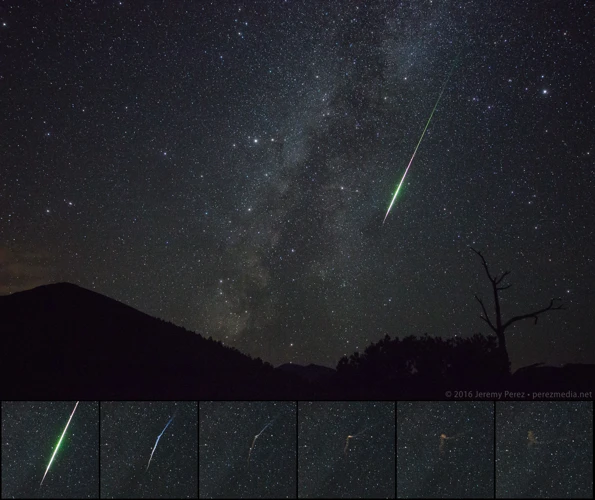
Capturing the beauty of the Perseid Meteor Shower through photography can be a rewarding and exciting experience. To ensure successful shots, follow these tips:
1. Use a Wide-Angle Lens: Wide-angle lenses allow you to capture a larger portion of the night sky, increasing your chances of capturing a meteor streak.
2. Long Exposure Settings: Set your camera to a long exposure time, typically between 15 to 30 seconds, to capture the trails of the meteors as they pass through the frame.
3. Set up a Sturdy Tripod: Keep your camera stable by using a sturdy tripod to prevent blurry images. Make sure to level the tripod and secure it firmly to avoid any movement during the long exposures. Additionally, using a remote shutter release or the camera’s timer function can further reduce camera shake. With these tips in mind, you’ll be ready to immortalize the graceful dance of the Perseids and create stunning photographs of this celestial spectacle.
1. Use a Wide-Angle Lens
When it comes to photographing the Perseid Meteor Shower, one essential tip is to use a wide-angle lens. A wide-angle lens allows you to capture a broader view of the night sky, increasing your chances of capturing those elusive shooting stars. With a wide-angle lens, you can frame the meteor shower against the backdrop of the vast expanse of stars, creating a more captivating and immersive image. This type of lens also helps capture the full beauty of the night sky, allowing you to include other interesting elements such as constellations or distant galaxies in your composition. Additionally, a wide-angle lens can help you capture multiple meteors in a single frame, enhancing the dramatic effect of the meteor shower. So, make sure to equip yourself with a wide-angle lens before embarking on your astrophotography adventure. Your camera will thank you for it.
2. Long Exposure Settings
When photographing the Perseid Meteor Shower, using long exposure settings can help capture the beauty and movement of the shooting stars. Long exposure refers to keeping the camera’s shutter open for an extended period, allowing more light to enter the sensor. This technique is especially useful for capturing the trailing streaks of meteors across the night sky. To set up your camera for long exposure, follow these steps:
- Use a sturdy tripod to ensure your camera remains stable throughout the long exposure.
- Select a wide aperture (low f-number) to let in as much light as possible.
- Set the ISO to a low value (e.g., ISO 100 or 200) to reduce image noise.
- Choose a long exposure time (e.g., 15-30 seconds) to capture the movement of the meteors.
- Use a remote shutter release or the camera’s timer to avoid camera shake when pressing the shutter button.
By utilizing long exposure settings, you can create stunning photographs that showcase the Perseid Meteor Shower in all its glory. So, don’t forget to bring your tripod and experiment with different exposure times to capture those mesmerizing shooting stars.
3. Set up a Sturdy Tripod
To capture the beauty of the Perseid Meteor Shower through photography, it is crucial to set up a sturdy tripod. The tripod serves as a stable base for your camera, preventing any unintentional movement or shaking that can result in blurry images. When choosing a tripod, look for one that is durable and can securely hold the weight of your camera and lens. It is also helpful to select a tripod with adjustable legs, allowing you to position your camera at different angles and heights. This flexibility can be particularly useful when capturing various compositions of the meteor shower. Additionally, consider using a tripod with a ball head or pan-tilt head, which enables smooth and precise adjustments for your camera positioning. By investing in a reliable and sturdy tripod, you can ensure that your photographs of the Perseids turn out sharp, detailed, and truly mesmerizing.
Notable Years and Predicted Peeks
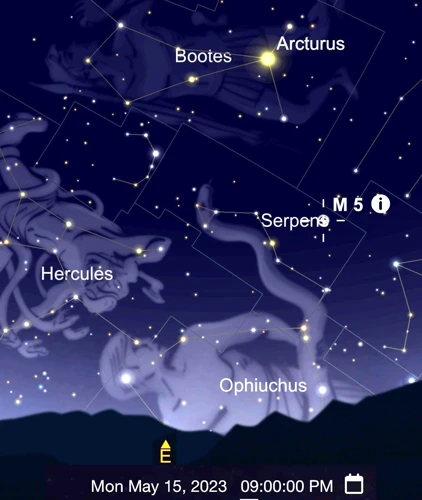
Notable Years and Predicted Peaks
The Perseid Meteor Shower is an annual event that occurs from late July to mid-August, with its peak typically falling around August 11th to 13th. While the shower is observable each year, certain years have stood out as particularly noteworthy. For example, in 2016, skywatchers were treated to an impressive display of the Perseids, with up to 200 meteors per hour visible during the peak. Another notable year was 1993, when the Perseids produced an outburst of activity, resulting in a breathtaking show of over 500 meteors per hour.
Predicting the exact intensity of the Perseid Meteor Shower can be challenging, as it depends on various factors such as the gravitational influences of other celestial bodies, the density of debris along the comet’s orbit, and the Earth’s own atmospheric conditions. However, astronomers and meteor experts make annual predictions based on historical data and observations. In general, it is expected that the Perseids will continue to be a reliable and popular meteor shower, with rates ranging from 50 to 100 meteors per hour during its peak.
To get the most out of your viewing experience, it is recommended to check online resources and consult with local astronomy clubs for the latest predictions on the best nights to observe the Perseids. Additionally, it is worth noting that the Perseid Meteor Shower coincides with the waxing crescent moon phase in most years, which provides optimal viewing conditions as the moon’s light won’t wash out the fainter meteors. So mark your calendars and prepare to witness nature’s celestial spectacle during the predicted peaks of the Perseid Meteor Shower.
(/the-solar-eclipse-witnessing-moons-shadow/)
Fascinating Perseid Meteor Shower Facts
Once you’re prepared to witness the magic of the Perseid Meteor Shower, here are a few fascinating facts to enhance your experience.
1. Swift-Tuttle: The Perseid Meteor Shower is caused by the debris left behind by the comet Swift-Tuttle, which was discovered in 1862 by Lewis Swift and Horace Parnell Tuttle. This comet has a diameter of about 26 kilometers and takes approximately 133 years to complete a single orbit around the Sun.
2. Shooting Stars: Despite their name, meteors are not stars. They are actually bits of space debris, mostly ranging in size from a grain of sand to a pebble, burning up in Earth’s atmosphere due to the intense heat caused by friction.
3. Fast and Furious: The Perseids are one of the most active meteor showers, with an average of 60 to 100 meteors visible per hour during the peak. These meteors travel at staggering speeds of around 59 kilometers per second (37 miles per second) as they streak across the night sky.
4. The Perseus Connection: The Perseid Meteor Shower appears to radiate from the constellation Perseus, located in the northeastern part of the sky. This radiant point is caused by the Earth’s movement through the debris trail left by the comet Swift-Tuttle.
5. Older than You Think: The Perseids have been observed for over 2,000 years, with the first recorded sighting dating back to ancient Chinese astronomers in 36 A.D.
6. Fireballs: The Perseids are known for producing spectacular fireballs, which are exceptionally bright meteors that leave behind glowing trails as they disintegrate. These fireballs are caused by larger particles entering the atmosphere and burning up more brightly.
7. Double Delight: Occasionally, the Perseids coincide with the Delta Aquariids Meteor Shower, resulting in a double meteor display. This rare occurrence can create an even more awe-inspiring celestial show in the night sky.
8. Comet Close-Up: The next time we will have a close encounter with the parent comet Swift-Tuttle will be in the year 2126. So, enjoy the Perseid Meteor Shower while it lasts and appreciate the unique astronomical event it represents.
Now armed with these fascinating facts, you can truly appreciate the wonder and beauty of the Perseid Meteor Shower. So find a comfortable spot, look up at the night sky, and let nature’s fireworks display leave you in awe of the vastness and magnificence of the universe.
Conclusion
In conclusion, the Perseid Meteor Shower is a spellbinding natural phenomenon that continues to captivate people from all walks of life. From its origins in the debris of the comet Swift-Tuttle to the dazzling display of shooting stars in the night sky, this celestial event reminds us of the vastness and beauty of the universe. Whether you’re an amateur astronomer or simply someone who appreciates the wonders of nature, witnessing the Perseids is an experience like no other. So mark your calendars, find a prime viewing spot, and prepare to be amazed by nature’s very own fireworks show. Don’t miss out on this opportunity to witness the celestial spectacle of the Perseid Meteor Shower. And if you’re hungry for more astronomical marvels, be sure to check out our articles on fascinating binary stars and the mysterious origins of supernovae.
Frequently Asked Questions
1. When is the Perseid Meteor Shower?
The Perseid Meteor Shower occurs annually in the month of August. The peak viewing nights usually fall around August 11th to 13th, although some meteors can be seen a few days before and after the peak.
2. How can I distinguish the Perseid meteors from regular shooting stars?
The Perseid meteors are known for their brightness and speed. They often leave long trails behind them and can be seen from various locations around the world.
3. Is it necessary to have a telescope or binoculars to observe the Perseid Meteor Shower?
No, you don’t need any special equipment to view the Perseid Meteor Shower. In fact, it’s best to use your naked eyes to have a wider field of view and catch as many meteors as possible.
4. Are there any specific times to watch the meteor shower?
The best time to observe the Perseid Meteor Shower is during the pre-dawn hours when the sky is darkest. However, meteors can be seen throughout the night, so you can start watching as soon as it gets dark.
5. Where is the best place to view the Perseid Meteor Shower?
The best viewing spots for the Perseid Meteor Shower are dark sky locations away from city lights. High elevation areas also provide better viewing as they offer a clearer view of the horizon.
6. How can I capture the Perseid Meteor Shower in photographs?
To photograph the Perseid Meteor Shower, you will need a DSLR camera with a wide-angle lens, a sturdy tripod, and long exposure settings. Follow our tips in the upcoming section for more detailed instructions.
7. Can I make a wish upon a shooting star from the Perseid Meteor Shower?
While it’s a popular belief that you can make a wish upon a shooting star, the Perseid Meteor Shower provides a magical opportunity to do so. So go ahead and make a wish as you witness these cosmic wonders.
8. Are there any other notable meteor showers throughout the year?
Yes, there are several other notable meteor showers throughout the year, such as the Geminids in December, the Orionids in October, and the Leonids in November. Each meteor shower has its own unique characteristics and viewing opportunities.
9. Can I listen to the sound of meteors during the Perseid Meteor Shower?
No, meteors do not produce sound as they burn up in the Earth’s atmosphere. The perception of sound often comes from sonic booms caused by larger meteoroids, but these occurrences are rare.
10. What should I bring with me for a comfortable meteor-watching experience?
It’s a good idea to bring a reclining chair or a comfortable blanket to lie on while watching the meteor shower. Dress warmly and bring snacks, drinks, and insect repellent if needed.

